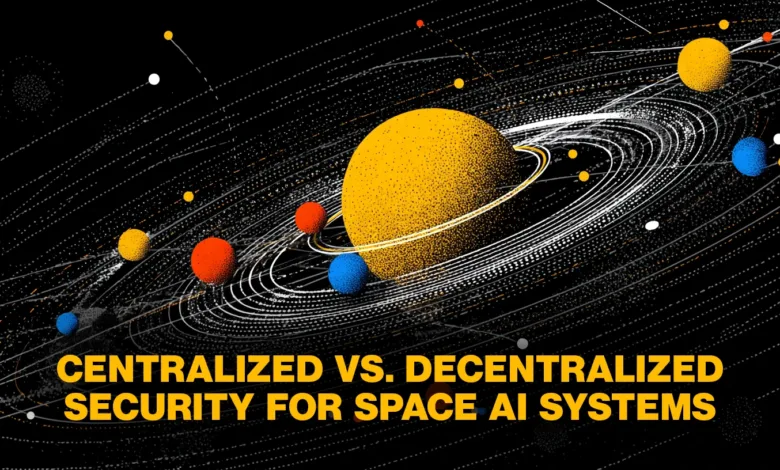Securing AI for Space Exploration

▼ Summary
– Cloud security complexity extends to satellites, which are moving endpoints requiring secure communication over delay-prone links.
– AI can automate space system security by detecting anomalies and malicious activity, with debate over centralized versus distributed control.
– Centralized AI architectures offer faster training but slower threat response, while federated learning reduces latency but complicates model synchronization.
– Commercial satellite operations are shifting toward centralized ground-based control due to better bandwidth and fewer hardware limitations on Earth.
– The research findings on AI security architectures have broader applications for distributed systems like manufacturing, connected cars, and energy grids.
Securing the complex networks of satellites orbiting our planet presents a unique cybersecurity frontier, demanding innovative solutions that can function across vast distances and through significant communication delays. A recent study investigates how artificial intelligence could automate the protection of these space-based systems, weighing the merits of centralized control against decentralized approaches.
The rapid expansion of commercial satellite constellations for broadband, imaging, and navigation is fundamentally reshaping the space industry. This growth introduces profound security challenges, as each satellite acts as a moving endpoint reliant on constant, yet delay-prone, communication links with ground stations. Every one of these connections represents a potential vulnerability.
Artificial intelligence is being positioned as a critical tool for automating risk management. AI systems can analyze telemetry data to identify anomalies, detect malicious activities, and recommend immediate countermeasures. The central debate revolves around where this computational intelligence should be housed, whether it should be trained and operated primarily from Earth or if satellites should possess their own onboard AI capabilities.
Researchers are evaluating three primary architectural models: centralized, distributed, and federated. In a centralized architecture, the bulk of the processing occurs on the ground. Satellites transmit their data to powerful Earth-based AI systems, which analyze it and send back security instructions. While this model benefits from the immense computing power available on Earth, leading to faster training times, its major drawback is the slower response to emerging threats caused by long signal travel times.
A distributed model offers a middle ground. Satellites still depend on ground stations for the initial training of AI models but are equipped to perform local inference, meaning they can make security decisions independently. This significantly cuts down the delay in responding to an incident, although the limited processing power onboard can sometimes reduce the accuracy of the AI models.
Federated learning pushes autonomy even further into space. In this setup, individual satellites train their own AI models using the data they collect, without sending that raw information back to Earth. They only share model updates with other satellites and ground control. This approach maintains low latency and enhances data privacy, but coordinating and synchronizing these models across an entire constellation of satellites presents a substantial technical hurdle.
A noticeable trend is emerging within the commercial satellite sector: a shift back toward centralization. According to co-author Noam Schmitt, major industry players are consolidating control on the ground. He points to services like AWS Ground Station, which centralizes satellite data management and integrates directly with AI platforms. Microsoft’s Azure Orbital and Google Cloud’s collaboration with SpaceX further indicate that the industry’s heavyweights are aligning around a model of central control. Schmitt notes that superior ground-based bandwidth and fewer hardware restrictions are key drivers behind this movement, with no major provider currently deploying significant onboard AI in their satellites.
Performance testing reveals trade-offs that will be familiar to any Chief Information Security Officer. In simulations, centralized learning achieved target accuracy roughly thirteen times faster than the largest federated configuration. However, the centralized model suffered from higher inference latency, which worsened as more satellites were added to the network. Federated systems, in contrast, maintained stable and low latency even as the constellation expanded. The takeaway is clear: centralized systems train quickly but react slowly, while federated designs train slowly but detect and respond to live threats with greater speed.
The architecture decision must also account for recovery and resilience in the wake of a security breach. As Robert Byrne, a Field Strategist at One Identity, explains, a major incident must be treated as a compromise of the entire infrastructure, ground, space, and user segments. Recovery will typically require restoring most systems from secure backups. He suggests that distributed Inter-Satellite Links can be a crucial architectural enhancement, enabling faster propagation of recovery updates and accelerating the restoration of the entire system.
Byrne also highlights that threats like DDoS attacks, jamming, and eavesdropping are on the rise, often fueled by geopolitical tensions. Yet, he identifies the human element as the most persistent vulnerability. “Social engineering and phishing attacks continue to be the most cost-effective and successful methods for compromising control systems, particularly within Satellite Control Centers,” he stated. Implementing zero-trust identity frameworks and emerging decentralized identity solutions could help mitigate these human-centric risks.
Looking forward, the research team plans to move beyond performance metrics to explore how these architectures handle critical issues like tenant isolation and data confidentiality. They see promise in technologies like digital twins, which can create high-fidelity simulations of a constellation to safely test security measures, and split learning, a technique that could reduce data transfer needs by dividing inference tasks between satellites and the ground.
Hybrid models may ultimately provide the most balanced solution. In such a system, satellites could handle immediate, local threat detection, while the ground station manages the more computationally intensive tasks of model training and long-term strategic analysis. This blend could deliver improved scalability and faster incident response without overburdening the limited computing resources available on the satellites themselves.
While this research is focused on space, the underlying design principles have far-reaching implications. The same core questions about data handling, communication reliability, and rapid threat detection apply to distributed manufacturing, connected vehicle networks, and smart energy grids. The lessons learned from securing satellite constellations will undoubtedly influence the evolution of AI-driven defense strategies across numerous terrestrial industries. Centralized control simplifies management but can create bottlenecks, whereas decentralized systems, though more complex to coordinate, offer superior resilience and speed. The optimal choice is not universal but depends entirely on the specific operational context.
(Source: HelpNet Security)





